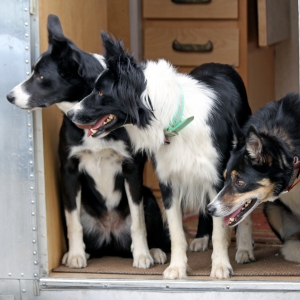I got a border collie, then someone gave me a book. I read the book and I said “Oh my God! The dog needs a job!” My first border collie I got at the pound, and she was not interested in sheep, but we did a little bit of agility. She died at a very young age from a heart condition that was undetected. Then I got another dog that was 5 years old, and I started out in a very, very difficult sport. I ended up with a rescue border collie, and he was really keen to work. I trained him, but he was not a team player. I ended up getting two more younger dogs with breeding I knew; they came from working lines. They both ended up with the same issue… Even though they were very different dogs, they weren’t well trained.
I decided if I was going to continue in the sport I might be better off with a ‘starter dog’ – a dog that is partially trained. That was Susie and she came to me 9 years ago from one of the top women handlers in North America. I was very lucky to get her; she’s a very good dog. Because she’s very nice to sheep, which gave me time to think. So she helped me learn how to handle a dog.
Then I got Dot a couple years later, but because she’s pushy, I had to change my handling technique. She’s taught me a lot.
Now I have Dahli, and I’m learning a lot. It hasn’t been fun, but I’m learning about how to train her because typical techniques don’t work with her. I have to remain calm, and not yell at her. I don’t use food because we work from a distance.
Tell me about your current dogs. Dot, Susie and Dahli. Dot is 8. Susie is 11. She’s retired from competing and will do farm chores. Dahli is 3 years old.
When Dot is good and listening, she’s very good in the field trials. And when she’s naughty, she’s naughty.
Dahli is learning.
How long does it take to train a dog? Typically four years to train them. One year for every paw, as they say. So some dogs can start at nine months, others aren’t ready until they’re a year and a half.
How often do they get worked? Rule of thumb: Light exercise; 3 to maintain; 5 to make progress. Dot gets tune-ups; Dahli gets more training. I only work her about 10 minutes as she gets tired. I also find that it’s the first thing you do, because it’s the first thing you do that counts. It’s not the third time. So I only train for 10 or 15 minutes at a clip and that’s it. I find I’m less frustrated and I also then can make the commitment easier.
What’s the first thing you teach? I believe in training off the field. So basic obedience: Can they sit? Can they lie down? Can they walk with you? So that starts to get them listening. I think that’s really important. When you first take them to sheep, some are very frightened, some show no interest, and some go YAHOO! Dot was a yahoo! kind of girl and Susie was always well-mannered. She’s a real lady.
When you first put them on sheep, they’re going to forget to lie down, walk and stay – they’ll lose their head. But at least they have that in their vocabulary and so when you get everything quiet and in balance then you can get the dog to come off you. “That will do” is a recall. That’s the other thing I also teach them.
When you take them into a ring to start training you do only balance work. Basically, you want the dog to balance to you. The sheep are in the middle. You’re on one side, at 6 o’clock, with the dog on 12 o’clock. If I move to 3, the dog goes to 9. If I’m at 12, the dog’s at 6. You do that, then a little walk up, and hopefully then, once they settle down, you are able to call them off.
Everything is done from a distance, so you use a lot of body language and a lot of verbal corrections. Once you feel like you have a little control in the ring, you’ll take them to a slightly larger area and continue to do balance work, little out runs, little go out behind the sheep and bring them to me.
That will do. Nancy Phillips and her husband Stephen Doherty own Windy Meadow Farm in Fayston, Vermont. Nancy trains the dogs; Stephen tends the sheep. More images, including sheep shearing, and their story of how Stephen became a shepherd, in next week’s post.



